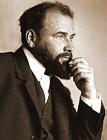
Click here to buy Sale Posters!
Gustav Klimt Biography
 Associated with art nouveau and the greater rebellion against traditional art, Gustav Klimt (1862-1918) was one of the most innovative and controversial artists of the early twentieth century. As his work evolved from the accepted classical-realistic style to one which was too bold, decorative and erotic for the establishment, he faced increasing criticism and attacks. In 1897 Klimt and a group of fellow artists formed the Secession, a group dedicated to challenging the conservative Academy of Fine Arts. With Klimt serving as president, The Secession in due course became the most influential artistic organization in Vienna.
Associated with art nouveau and the greater rebellion against traditional art, Gustav Klimt (1862-1918) was one of the most innovative and controversial artists of the early twentieth century. As his work evolved from the accepted classical-realistic style to one which was too bold, decorative and erotic for the establishment, he faced increasing criticism and attacks. In 1897 Klimt and a group of fellow artists formed the Secession, a group dedicated to challenging the conservative Academy of Fine Arts. With Klimt serving as president, The Secession in due course became the most influential artistic organization in Vienna.
Gustav Klimt was born in Baumgarten, a suburb of Vienna, on July 14, 1862. He grew up in poverty though his father, an engraver of gold and silver by trade, encouraged him to pursue a career in art. His formal artistic training began at Kunstgewerbeschule in Vienna and continued at the Vienna School of Decorative Arts. In 1882, Klimt, his younger brother Ernst, along with fellow student Franz Matsch formed a company of artists. They painted murals as well as traditional paintings for a variety of patrons and managed to earn a considerable income.
"All art is erotic." ~ Gustave Klimt
As Klimt's art evolved, it revealed elements that would characterize his later work: concentrated areas of detail, gold paint (an apparent allusion to his father's trade), classical symbolism, areas of abstract space, and the female form.
In 1893 Klimt and Matsch were commissioned to decorate a hall in the new University of Vienna. As they worked on the commission, a serious rift developed between Klimt & Matsch. It progressed to the point where the two men would not work in the same studio. When Klimt exhibited his painting Philosophy, a controversy was ignited and he was attacked on several fronts. Eighty-seven members of the University publicly protested the painting and petitioned the Ministry of Education to cancel the commission. Karl Kraus, a Viennese journalist, characterized Klimt's handling of the issues inherent in the commission as simple-minded. Other academics found the symbolism too vague, while Catholics took exception to the nudity.
"I have the gift of neither the spoken nor the written word, especially if I have to say something about myself or my work� Whoever wants to know something about me - as an artist, the only notable thing - ought to look carefully at my pictures and try and see in them what I am and what I want to do." ~ Gustave Klimt
Subsequent paintings, Medicine and Jurisprudence created a similar reaction with further calls for the University to cancel the commission. Though the paintings were accepted by the Artistic Advisory Committee of the Ministry, it was decided that rather than go to the University, the paintings would go instead to the State Gallery of Modern Art.
The attack on his art along with the acerbic reception of all modern art led Klimt along with Carl Moll, Josef Engelhart and eight others to leave the Association of Viennese Artists (K�nstlerhausgenossenschaft) and to form the Secession. The group, whose motto was To every age its art, to art its freedom, promised to exhibit unconventional artists, to bring quality foreign art to Vienna, and to publish a magazine. Over 57,000 visitors attended the first exhibition of foreign work organized by the Secession in 1898. By 1900, the Secession had usurped the K�nstlerhausgenossenschaft in prestige and influence.
"I want to liberate myself. I want to break away from all these unpleasant, ridiculous aspects which restrict my work." ~ Gustave Klimt
In 1904, after more criticism and debate over his work, Klimt opted out of his commission from the Ministry of Education and bought back his three completed paintings.
After 1900, Klimt concentrated on portraits and landscapes. During this period, however, he did produce two of his finest murals - The Beethoven Frieze (shown at the Secession gallery in 1902) and decorations for the Palais Stoclet in Brussels (1904-1911). His highly ornamental style with flowing lines, biomorphic forms and brilliantly composed areas of decoration, as exemplified in The Kiss became a trademark of the Secession. Ironically, Klimt himself left the group in 1905, after a disagreement with Josef Hofmann, and continued on his own solitary path.
"I have never painted a self-portrait. I am less interested in myself as a subject for a painting than I am in other people, above all women." ~ Gustave Klimt
Klimt believed that art should not be confined to studios and traditional modes of presentation. He designed posters, worked as an illustrator, designed fashion and jewelry, and painted murals while creating few works on canvas. His ideas were reborn in the 1960's with the Pop Art Movement. In 2003 his masterpiece, Landhaus am Attersee, sold for $29,128,000.
On January 11, 1918 Klimt suffered a stroke at home in his apartment. He died on February 6th from pneumonia.
Copyright � 2004- by Ace Toscano. All rights reserved.
(We are not affiliated with sites or advertisers promoted in paid ads appearing on this or any page.)
�
